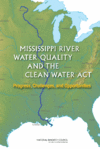The chemical spill in West Virginia put a fine point on it. We are all vulnerable when it comes to clean water.
 Of course, the Mississippi River is included. Over 50 cities get their drinking water from the Mississippi River. That’s nearly 18 million people. And then there are the birds – 40% of North America’s species – that rely on the River for clean water on their migratory flyway; the animals – 50+ mammal species – whose habitat is impacted by the availability and cleanliness of the River; and the Gulf’s fish and seafood – nearly 1.7 billion pounds in 2000 – whose habitat depends on the freshness (or non-freshness) of the Mississippi River’s water as its sediment filters its way to the sea.
Of course, the Mississippi River is included. Over 50 cities get their drinking water from the Mississippi River. That’s nearly 18 million people. And then there are the birds – 40% of North America’s species – that rely on the River for clean water on their migratory flyway; the animals – 50+ mammal species – whose habitat is impacted by the availability and cleanliness of the River; and the Gulf’s fish and seafood – nearly 1.7 billion pounds in 2000 – whose habitat depends on the freshness (or non-freshness) of the Mississippi River’s water as its sediment filters its way to the sea.
We know there are threats to this water source and yet we wait for disasters like West Virginia to remind us.
A few weeks ago I learned about states and cities that are planning ahead. Minnesota, Virginia, Wisconsin and Kentucky have all adopted programs and a variety of funding mechanisms: cell phone charges; sales tax percentages; itemizing payments on utility bills. Cities like Sao Paulo, Brazil bill industry annually for water cleanup and Bloomington, Illinois relies on grants and partnerships.
But the scale of the Mississippi River and its watershed challenges even the most innovative of us.
In the U.S., taxation or fees for clean water rely on the public’s willingness to pay. We’re usually willing to make these payments locally because we understand our stake in the outcome. When we think of a river system as big as the Mississippi River, ways to pay to ensure its quality break down across borders and over long distances.
This is where increasing the public’s awareness of their stake in America’s great river and its future comes in. Despite regulation and top-down, “command and control” rules for discharge abatement and run-off reduction, only a portion of the Mississippi’s more than 1,500 gallons of water per day are treated, and the hypoxia-induced “dead zone” in the Gulf of Mexico remains the same or grows. Even with millions of USDA dollars going into the development of new farming practices, it still only addresses hundreds-of-acres here and hundreds-of-acres there. We’re talking thousands of square-miles of the world’s most productive farmland drained by the Mississippi Watershed.
So while we need targeted efforts and we need funding support on a scale that is the Mighty Mississippi, we won’t get either if the American public doesn’t grasp its stake in a cleaner, more sustainable Mississippi River. It’s time to build that awareness of the River’s role in our country’s and the world’s food security, and its life-giving role in individual communities, and its economic-driver role to the nation. Without that public awareness, the Mississippi River and its water will continue to be threatened until a greater catastrophe than the one in West Virginia comes along.

